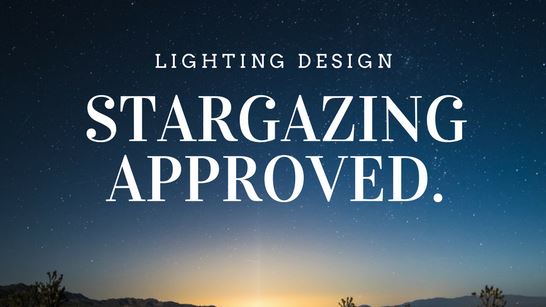There’s little that’s as pretty as twinkling stars and a bright moon in a dark night sky. Unfortunately, however, urban dwellers often have only the bright lights of tall buildings to light up the night.
Even in sprawling suburbs, some homeowners experience the glow — or the glare — of neighbors’ interior lights, exterior fixtures and landscape lighting, not to mention the disruptive brightness of street lights, traffic signals and neon. The stars, in some communities, have all but disappeared. That’s a shame, for reasons that may affect human and animal health, as well as the beauty of the night.
In Arizona, we are fortunate to be one of the 18 states to have enacted light pollution regulations in the form of dark sky ordinances. While we may not be able to view 2,500 stars every night in our local “big bowl” of sky overhead, we do see more than the average few hundred because of a state law that was enacted in 1986. Compliance with the regulations also helps to save energy.
Safety, Style and Compliance with Dark Sky Ordinances
While safety concerns are among the foremost reasons for lighting a home’s exterior, there are ways to do it that don’t contribute to overall light pollution. Certainly, motion-activated lighting puts light where and when it’s needed to assure safe passage, and eliminates the requirement for homeowners to check and recheck their lighting settings.
Style is another concern and, again, we are fortunate in our area to enjoy a predominant architectural style that allows shielded lighting fixtures as trendy complements to a home’s exterior materials and design. Exterior lighting is largely a matter of individual choice and personal preference, but local custom designers and national suppliers are well aware and supportive of the requirements.
Finally, compliance with the existing dark sky ordinance is not difficult. Basically, the requirements stipulate that architects and designers, builders and owners use the lowest possible wattage to produce effective results. Light should be concentrated where it is needed — to illuminate steps, for instance, or focus light on a keyed lock, or allow house numbers to be viewed from the street. Shielded tops on exterior fixtures not only keep light from shining toward the sky, but can also help to keep flying pests at bay. Usually, fixtures with clear sides and open bulbs are disallowed, although in some cases, low wattage bulbs may be acceptable for warning lights or security purposes.
Adding Style to Nighttime Beauty
There are plenty of ways to add beauty to your home and still comply with existing regulations. Wall sconces, pedestal lights and landscape lighting incorporate required shielding as part of the design. Basic “dark sky”rules stipulate that lighting, in addition to being shielded should:
- Only be on when necessary
- Light only the areas that need it
- Be no brighter than is needed
- Limit blue light emissions
At Aterra, we can suggest a variety of ways to assure that these additional rules are met.
While we generally concur with the requirements, we also know there are occasions when brighter light may be necessary for a short period of time. Installing sensors can produce light when it is necessary, but installing a dimmer would allow brighter light to aid an owner or a visitor with impaired vision or mobility problems.
We’d be happy to discuss other options for compliance as well as the full range of interior and exterior lighting design and electrical customization, including home automation and smart home options. We’re in the business of lighting up your home, but we’re also interested in counting those stars!


